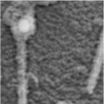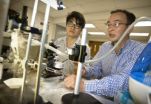(Press-News.org) The most common type of hospital-associated infection may be preventable with a vaccine, new research in mice suggests.
The experimental vaccine, developed by researchers at Washington University School of Medicine in St. Louis, prevented urinary tract infections associated with catheters, the tubes used in hospitals and other care facilities to drain urine from a patient's bladder.
Each day a catheter is present in the urethra and the bladder, the risk of urinary tract infection increases. Nearly every patient who has a catheter for more than 30 days acquires a urinary tract infection. The infections make urination painful and can damage the bladder. If untreated, bacteria can cross into the bloodstream and cause sepsis, a potentially life-threatening complication.
"Catheter-associated urinary tract infections are very common," said first author Ana Lidia Flores-Mireles, PhD, a postdoctoral research associate at the School of Medicine. "Antibiotic resistance is increasing rapidly in the bacteria that cause these infections, so developing new treatments is a priority."
The study is available online Sept. 17 in Science Translational Medicine.
Manufacturers typically coat catheters with antibiotics to reduce the risk of infection. But Flores-Mireles and her colleagues in the laboratory of Scott Hultgren, PhD, showed that inserting catheters into the bladder provokes an inflammatory response that results in the catheter being covered with fibrinogen, a blood-clotting protein.
Fibrinogen shields bacteria from the antibiotics and provides bacteria with a landing pad to adhere to and food to consume as they establish an infection, the research revealed.
"The bacteria use long, thin hairs known as pili to anchor themselves to the fibrinogen, and then they can start to form biofilms, which are slimy coatings on the surface of the catheter composed of many bacteria," said co-author Michael Caparon Jr., PhD, professor of molecular microbiology. "The biofilms protect the bacteria from antibiotics and immune cells, further prevent them from being washed from the body by the flow of urine, and make it possible for bacteria to seed the lining of the bladder with infections."
The urethra and bladder of a mouse are too small to insert a full catheter into, but the scientists showed that surgically implanting a small segment of catheter into the bladder via the urethra increased vulnerability to infection in a similar fashion.
Working with Enterococcus faecalis, a common cause of catheter-associated urinary tract infections, Flores-Mireles showed that a protein on the end of the pili, EbpA, binds to fibrinogen and makes it possible for the bacteria to begin forming biofilms.
When Flores-Mireles prevented the bacteria from making EbpA, they couldn't start infections.
"This protein is like the anchor of a boat," she said. "Without the anchor, the infection is at the mercy of the waves and gets washed away."
Next, the researchers injected the mice with a vaccine containing EbpA. The vaccine caused the animal's immune systems to produce antibodies that blocked EbpA and stopped the infectious process.
The scientists are testing to see if the vaccine helps mice clear established infections of E. faecalis. They also are working to develop a monoclonal antibody that blocks EbpA to prevent catheter-associated infections in the urinary tract and elsewhere in the body.
"We took a closer look at this protein and found that one-half of it is essential for binding to fibrinogen to induce infections," Flores-Mireles said. "The segment of genetic code that makes this part of the protein is also found in the genes of many other bacteria that cause urinary tract infections, so a vaccine, antibody or drug that blocks this part of the protein may help prevent other infections linked to catheters in the urinary tract and in other parts of the body."
INFORMATION:
The research was based at Washington University's Center for Women's Infectious Disease Research, which is directed by Hultgren, the Helen L. Stoever Professor of Molecular Microbiology.
This work was supported by a Berg-Morse Postdoctoral Fellowship and National Institute of Diabetes and Digestive and Kidney Diseases grants R01-DK051406 and P50-DK0645400 from the National Institutes of Health (NIH).
Flores-Mireles AL, Pinkner JS, Caparon MG, Hultgren SJ. EbpA vaccine antibodies block binding of Enterococcus faecalis to fibrinogen to prevent catheter-associated baldder infection in mice. Science Translational Medicine, online Sept. 17.
Washington University School of Medicine's 2,100 employed and volunteer faculty physicians also are the medical staff of Barnes-Jewish and St. Louis Children's hospitals. The School of Medicine is one of the leading medical research, teaching and patient-care institutions in the nation, currently ranked sixth in the nation by U.S. News & World Report. Through its affiliations with Barnes-Jewish and St. Louis Children's hospitals, the School of Medicine is linked to BJC HealthCare.
In mice, vaccine stops urinary tract infections linked to catheters
2014-09-18
ELSE PRESS RELEASES FROM THIS DATE:
Migraine in middle age linked to increased risk of Parkinson's, movement disorders later
2014-09-17
MINNEAPOLIS – A new study suggests that people who experience migraine in middle age may be more likely to develop Parkinson's disease, or other movement disorders later in life. Those who have migraine with aura may be at double the risk of developing Parkinson's, according to the study published in the September 17, 2014, online issue of Neurology®, the medical journal of the American Academy of Neurology.
"Migraine is the most common brain disorder in both men and women," said study author Ann I. Scher, PhD, with Uniformed Services University in Bethesda, MD, and ...
For some lung cancer patients, surgery may yield better long-term results
2014-09-17
(September 17, 2014, San Francisco) – Patients with early stage non-small cell lung cancer (NSCLC) who are otherwise healthy fare better over time if they undergo conventional surgery versus less-invasive radiosurgery to remove their cancer, according to a Yale study. The findings are scheduled to be presented at the 56th annual conference of the American Society for Radiation Oncology in San Francisco. (Abstract # 302; Comparative Effectiveness of Stereotactic Body Radiotherapy versus Surgery for Stage I Non-Small-Cell Lung Cancer.)
The study used Medicare billing records ...
Brain imaging research pinpoints neurobiological basis for key symptoms associated with post-traumatic stress disorder like listlessness and emotional detachment in trauma victims
2014-09-17
NEW YORK, NY, September 17, 2014 - In a novel brain-imaging study among trauma victims, researchers at NYU Langone Medical Center have linked an opioid receptor in the brain -- associated with emotions -- to a narrow cluster of trauma symptoms, including sadness, emotional detachment and listlessness. The study, published online today in the journal JAMA Psychiatry, holds important implications for targeted, personalized treatment of post-traumatic stress disorder, or PTSD, a psychiatric condition affecting more than 8 million Americans that can cause a wide range of debilitating ...
PTSD symptoms associated with increased food addiction
2014-09-17
Bottom Line: Symptoms of posttraumatic stress disorder (PTSD) were associated with increased food addiction, especially when individuals had more symptoms or the symptoms occurred earlier in life.
Authors: Susan M. Mason, Ph.D., of the University of Minnesota, Minneapolis, and colleagues.
Background: PTSD is a potentially severe psychiatric condition. A growing body of evidence suggests that PTSD is a risk factor for obesity and obesity-related diseases. Food addiction is not established as a psychiatric diagnosis but may indicate use of food to cope with psychological ...
Vitiligo treatment holds promise for restoring skin pigmentation
2014-09-17
VIDEO:
Henry Lim, M.D., chair of Dermatology, Henry Ford Hospital, highlights the study.
Click here for more information.
DETROIT – A treatment regimen is safe and effective for restoring skin pigmentation in vitiligo patients, according to a Henry Ford Hospital study.
"Our findings offer patients with vitiligo worldwide a renewed hope for a bright future in the treatment of this disfiguring disease," says Henry Lim, M.D., chair of Dermatology at Henry Ford and the study's ...
Combo of phototherapy, drug results in faster repigmentation in vitiligo
2014-09-17
Bottom Line: Patients with the skin depigmentation disease known as vitiligo had faster and better repigmentation after a combination therapy of the implantable drug afamelanotide and narrowband UV-B (NB-UV-B) phototherapy as part of a clinical trial.
Author: Henry W. Lim, M.D., of Henry Ford Hospital, Detroit, Mich., and colleagues.
Background: Vitiligo is characterized by white patches of skin and affects 1 percent to 2 percent of the population. The authors report the results of a multicenter randomized clinical trial comparing the safety and effectiveness of the ...
Chromosome buffers hold key to better melanoma understanding
2014-09-17
Buffers that guard against damage to the ends of chromosomes could hold the key to a better understanding of malignant melanoma – the deadliest form of skin cancer – according to new research from the University of Leeds.
The study has uncovered an important new genetic risk factor for melanoma.
It is well known that pigmentation and mole count are the strongest indicators of those most at risk of developing melanoma. For example, paler people should take more care in the sun, as they burn more easily.
It now appears that another risk factor is the length of telomeres, ...
NASA sees Tropical Storm Polo intensifying
2014-09-17
Tropical storm warnings now issued for a portion of the Southwestern coast of Mexico as Polo continues to strengthen. Infrared imagery from NASA's Aqua satellite showed powerful thunderstorms around the center of the storm.
A Tropical Storm Warning is in force for the southwest coast of Mexico from Punta San Telmo to Playa Perula. A Tropical Storm Watch is in force from Punta San Telmo to Zihuatanejo and from Playa Perula to Cabo Corrientes. Rainfall totals of 5 to 10, locally up to 15 inches, can be expected over coastal areas of Michoacan, Colima and Jalisco states ...
NASA sees Hurricane Edouard far from US, but creating rough surf
2014-09-17
Although NASA's Aqua satellite showed that Hurricane Edouard is far from U.S. soil, it is powerful enough that it is creating dangerous swells along the U.S. East Coast.
On Sept. 17, the National Hurricane Center noted "Swells from Edouard will affect portions of the east coast of the United States north of Florida beginning today. These swells will likely cause life-threatening rip current conditions along most of the United States east coast for the next couple of days."
When NASA's Aqua satellite passed over Hurricane Edouard on Sept. 16 the MODIS instrument captured ...
Shorebird's beak inspires UT Arlington research on water collection
2014-09-17
A UT Arlington engineering professor and his doctoral student have designed a device based on a shorebird's beak that can accumulate water collected from fog and dew.
The device could provide water in drought-stricken areas of the world or deserts around the globe.
Cheng Luo, professor in the Mechanical & Aerospace Engineering Department, and Xin Heng, PhD candidate in the same College of Engineering department, published "Bioinspired Plate-Based Fog Collectors" in the Aug. 25 edition of ACS' (American Chemical Society) Applied Materials & Interfaces journal. ACS also ...




